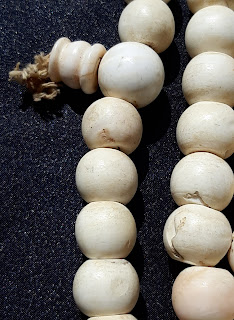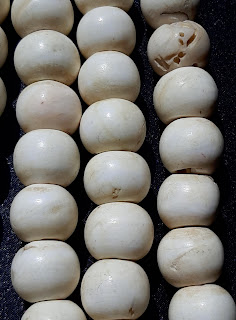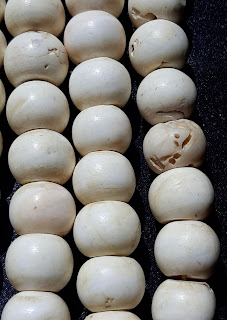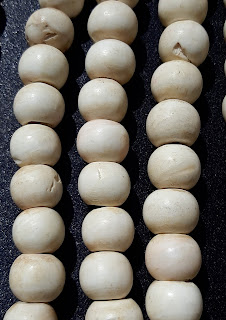佛教七寶之首西藏天然老硨磲雕 108 + 1 顆佛念珠項鍊
The first of the Seven Treasures of Buddhism, Tibetan Natural Old Tridacna Carved 108 + 1 Buddha Rosary Beads Necklace
https://youtu.be/2rbnvdTJ6xY?si=dSumhbkqJoLOtcrf
https://youtu.be/DUbHMymsZDI?si=DXiRQdY7Vm4dg3_u
全重:983 公克 grams
尺寸:每個硨磲雕佛念珠 高 1.5 厘米 cm x 珠圓直徑 1.7 厘米 cm x ( 108 + 1 ) 顆
項鍊圓周長:90 x 2 = 180 厘米 cm
Total weight: 983 grams
Dimensions: Each Tridacna Carved Buddha Rosary Bead Height 1.5 cm x Bead Circle Diameter 1.7 cm x ( 108 + 1 ) pieces
Necklace circumference: 90 x 2 = 180 cm
此硨磲雕佛念珠具有天然的生長紋及一些蟲眼與裂紋。古人想要獲得硨磲很不容易,因此它也就顯得彌足珍貴。三國時期魏文帝曹丕《車渠椀賦序》就提到:「車渠,玉屬也,多纖理縟文。生於西國,其俗寶也。」。漢代的伏勝在《尚書大傳》中記載,周文王被商紂王囚禁之後,他的大臣散宜生就是用硨磲大貝贖回了周文王。在清朝,二品官員上朝時所佩戴的朝珠是硨磲做成的,六品官員的朝冠頂上頂珠也是硨磲所製,其純白的顏色象徵著統治階級的高貴,純潔與清廉。在西方,硨磲的身份同樣高貴,與珊瑚、珍珠和琥珀並稱為四大有機寶石。
在中國佛教中,金、銀、琉璃、珊瑚、琥珀、硨渠、瑪瑙稱為佛教七寶。硨磲是稀有的有機寶石,亦是佛教聖物,象徵著純潔高貴,位列佛教七寶之首,是佛教高僧供佛的重要法器,能消災解厄、降惡聚靈、降臨福祉、庇佑子孫,鎮宅辟邪。佛教認為,硨磲飾品帶來了大海裡強大的氣場,蘊含著一種正能量,是有避邪的功能,做成藝術品陳列於案頭,或者做成佛念珠戴在身上,可以給家宅和自身帶來祥和百福。作為世界上佛教信徒最多的國家,硨磲在中國自然也受到越來越多人士的追捧與喜愛。
此西藏天然老硨磲雕佛念珠項鍊竟然能夠收集高達 108 + 1 顆珠圓近乎直徑 1.7 厘米的天然老硨磲雕佛念珠,實屬相當不容易,因此它也就顯得更為彌足珍貴。
These Tridacna Carved Buddha Rosary Beads have natural growth patterns and some insect holes and cracks. It was not easy for the ancients to obtain Tridacna, so it was extremely precious. Cao Pi, Emperor Wen of Wei Dynasty during the Three Kingdoms period, mentioned in his "Preface to the Ode of the Cheque (Tridacna) Carved Bowl": "Cheque (Tridacna) belongs to the jade genus and has many fine textures. It was born in the Western Kingdom and is a common treasure." Fu Sheng of the Han Dynasty recorded in "Shangshu Da Zhuan (Great biography)" that after King Wen of Zhou was imprisoned by King Zhou of Shang, his minister San Yisheng redeemed King Wen of Zhou with huge clams and shells of Tridacna. In the Qing Dynasty, the court necklace beads worn by second-rank officials when they went to court were made of Tridacnas, and the beads on the crown hats of sixth-rank officials when they went to court were also made of Tridacnas. Their pure white color symbolized the nobility, purity and incorruptibility of the ruling class. In the West, Tridacna has an equally noble status and is known as the four major organic gemstones along with coral, pearls and amber.
In Chinese Buddhism, gold, silver, colored glaze, coral, amber, tridacna and agate are called the Seven Treasures of Buddhism. Tridacna is a rare organic gemstone and a sacred object of Buddhism. It symbolizes purity and nobility. It ranks first among the Seven Treasures of Buddhism. It is an important Buddhist instruments offered by Buddhist monks to the Buddha. It can eliminate disasters, ward off evil and gather spirits, and bring blessings, as well as bless your descendants, guard your house and ward off evil spirits. Buddhism believes that Tridacna ornaments bring a powerful aura in the sea, contain a kind of positive energy, and have the function of warding off evil spirits. They can be made into works of art and displayed on the desk at home, or made into Buddhist rosary beads to wear on the body, which can bring peace and happiness to your family and yourself. As the country with the largest number of Buddhist believers in the world, Tridacna is naturally sought after and loved by more and more people in China.
This Tibetan natural old Tridacna carved Buddha rosary beads necklace was enabled to be actually collected up to 108 + 1 pieces of natural old Tridacna carved Buddha rosary beads all with a diameter of nearly 1.7 cm. It was not that easy, so it is even extremely more precious.
Works of Art
Provenance:
Ms. Chen Junying (1932- ). Her father Chen Wancheng was the 20th generation descendant from the ancestor Chen Xiufu [Official name: Guangludafu, an official who was close to the Emperor, and acted according to the edict of the Emperor, also the founding hero of the Ming Dynasty, from Wuhua, Guangdong.], who was nominated as the military Marshal by Ming Emperor Zhu Yuanzhang in Hongwu 18th year (1385 A.D.) Ming Dynasty. She has inherited the family handed-down ancestral collection, including valuable ceramics, jade carved works of art, antiques, bronzes, and Chinese paintings moving from mainland China to Taiwan since Qing dynasty, from her father Chen Wancheng and has been trained to be a good professional collector and an excellent appraiser by family education since childhood for over 80 years.
Chen Xiufu
Official name: Guangludafu, an official who was close to the Emperor, and acted according to the edict of the Emperor, also the founding hero of the Ming Dynasty, from Wuhua county, Guangdong Province, China.
Chen Xiufu was nominated as the military Marshal by Ming Emperor Zhu Yuanzhang in Hongwu 18th year (1385 A.D.) Ming Dynasty.
http://www.nanchens.com/xqxx/xqxx32/xqxx32510.htm
https://www.xuehua.tw/a/5ec8742f868e1a463e412f06
https://ppfocus.com/0/cu4cb061d.html
藝術品
來源:
陳俊英女士 ( 1932 - )。她的父親陳萬承是明朝洪武十八年 (公元 1385 年) 被明朝皇帝朱元璋封為軍事大元帥的先祖陳秀甫 (明代開國功臣光祿大夫 [為皇帝近臣依皇帝詔命行事] 陳秀甫 [廣東五華籍]) 的第 20 代後裔。她從父親陳萬承處繼承了家族傳世的祖傳藏品,包括自清朝以來從中國大陸移至台灣的珍貴陶瓷器、玉器、古董、青銅器和中國書畫,她自童年開始透過家庭教育,即被培養成為一位很棒的專業收藏家和優秀的鑑賞家已達 80 多年。
陳秀甫
陳秀甫是明代的開國功臣光祿大夫 [此官名為皇帝近臣依皇帝詔命行事],中國廣東省五華縣人。
明朝洪武十八年 (公元 1385 年) 陳秀甫被明朝皇帝朱元璋封為軍事大元帥。
http://www.nanchens.com/xqxx/xqxx32/xqxx32510.htm
https://www.xuehua.tw/a/5ec8742f868e1a463e412f06
https://ppfocus.com/0/cu4cb061d.html
%206000%20(1)%20(1).png)
%206000%20(2).png)





































































沒有留言:
張貼留言